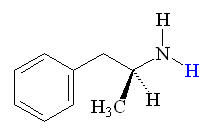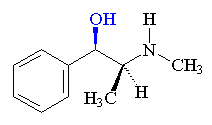|

METHAMPHETAMINE
(and its isomers)
(a.k.a. methedrine, speed, crank, meth, ice, glass, crystal meth, etc.)

Simon Cotton
Uppingham School, Rutland, UK

Molecule of the Month March 2007
Also available: JSMol version.

|

Alain Baxter of Britain skis the second run of the men's slalom
at the Salt Lake 2002 Winter Olympic Games in Deer Valley February 23, 2002.
Jean-Pierre Vidal of France eventually won Olympic gold in the slalom,
ahead of silver medalist Sebastien Amiez of France, and bronze medallist Alain Baxter of Britain.
©REUTERS/Wolfgang Rattay |
A Briton gets a podium finish in Olympic Skiing? You'll be telling me there's a Jamaican bobsleigh team next!
On 23rd February 2002, the Scot Alain Baxter finished 3rd in the slalom at the Winter Olympics at Salt Lake City. He became the first Briton ever to win a medal in alpine skiing. After that, things rapidly went downhill for Baxter. Within days, tests on a urine sample revealed traces of methamphetamine. After a 2-day hearing, the International Olympic Commission announced on March 21st that Baxter must return his bronze medal. His 3rd place would be removed from the Olympic record books. Baxter's subsequent appeal failed, but whilst the Court of Arbitration for Sport (CAS) upheld the International Olympic Committee's decision to strip him of the medal, they accepted that Baxter had acted honestly throughout. The Fédération Internationale de Ski (International Ski Federation) imposed the minimum 3-month suspension.
Why did Baxter take methamphetamine?
 Alain Baxter had a longstanding medical condition, nasal congestion. Back in the UK, he regularly used British Vicks nasal inhalers. These use chemicals such as menthol, camphor and methyl salicylate (wintergreen) and exert their effect through shrinking inflamed membranes. When the problem recurred in Salt Lake City, Baxter found that the team doctor's original suggestion did not work, and when he saw a Vicks inhaler in a shop that appeared identical to the ones he used in the UK, he bought it. Sadly although it looks the same, American Vicks contains compounds not found in the British version, including L-methamphetamine. L-methamphetamine is simply a decongestant, and has no stimulant activity. But its optical isomer, D-methamphetamine, is the stimulant commonly known as speed.
Alain Baxter had a longstanding medical condition, nasal congestion. Back in the UK, he regularly used British Vicks nasal inhalers. These use chemicals such as menthol, camphor and methyl salicylate (wintergreen) and exert their effect through shrinking inflamed membranes. When the problem recurred in Salt Lake City, Baxter found that the team doctor's original suggestion did not work, and when he saw a Vicks inhaler in a shop that appeared identical to the ones he used in the UK, he bought it. Sadly although it looks the same, American Vicks contains compounds not found in the British version, including L-methamphetamine. L-methamphetamine is simply a decongestant, and has no stimulant activity. But its optical isomer, D-methamphetamine, is the stimulant commonly known as speed.
 |
 |
(S)-(+)-methamphetamine
or D-methamphetamine |
(R)-(-)-methamphetamine
or L-methamphetamine |
Methamphetamine is the methyl-derivative of the amphetamine molecule, which also has optical isomers. The D- form is often called Dexedrine, and is another stimulant often used to treat insomnia, ADHD, narcolepsy, fatigue and sometimes depression. The methyl group that replaces the H in amphetamine to make methamphetamine is shown in blue in the structures above and below.
 |
(S)-(+)-amphetamine or Dexedrine
The blue H is replaced by CH3 in methamphetamine |
If the L-methamphetamine that Baxter took was not a stimulant, why did he lose his medal?
IOC regulations simply forbid the use of "methamphetamine". They do not distinguish between the two isomers. Neither do the IOC testing procedures as used at the 2002 Winter Olympics. The optical isomers of methamphetamine can be separated (and distinguished) by high pressure liquid chromatography (HPLC) using a chiral column. Baxter requested that the IOC tested his urine samples to confirm which isomer was present, a request that was declined.
Why do the isomers of methamphetamine have different effects in the body?
Methamphetamine contains a chiral carbon atom, and therefore exists as two optical isomers, non-superimposable mirror images of each other. The isomers have identical chemical reactions, solubilities and melting points. [It is possible that they have different smells, as the isomers of amphetamine itself are reported to differ]. They just differ in their opposite rotations of plane-polarised light and, because they have different 3-D structures, they fit chiral protein receptors differently, and therefore have different effects upon the body.
How is methamphetamine made?
Laboratories in many places, notably throughout the USA, are engaged in clandestine manufacture of methamphetamine. The chemistry is well understood, and widely published, notably on the web, though not easy to achieve. It is the synthesis of methamphetamine that is illegal. Two methods that have been described both involve the reduction of ephedrine (itself readily available) using either lithium in liquid ammonia as the reducing agent, or else red phosphorous and iodine to generate HI for the reduction.
 |
 |
 |
| Ephedrine |
|
Methamphetamine |
A further process involves the reductive amination of phenylacetone, first converting it into the formyl amide of methamphetamine, then hydrolysing the amide with HCl(aq).
 |
 |
 |
 |
 |
| Phenylacetone |
|
Formyl amide of methmphetamine |
|
D-methamphetamine |
Much of this synthetic chemistry is difficult and dangerous outside a proper laboratory, fires and explosions, as well as chemical burns to individuals, are reportedly common. Don't try these at home, folks.
How does D-methamphetamine work on the body?
It promotes release of abnormal amounts of the important neurotransmitter dopamine. This has the effect of stimulating regions of the brain linked with vigilance and the action of the heart. For a short while, the user feels sharper, stronger and more energetic. It is believed that a significant proportion of the dopamine-producing cells in the brain can be damaged by prolonged exposure to even low levels of methamphetamine, and this is responsible for reduced levels of dopamine; this can affect memory-, attention- and decision-taking functions. Chronic methamphetamine abuse is reported to lead to significant reduction in grey matter in the brain, greater than those in dementia or schizophrenia patients, though this needs further clarification. Associated health risks involve social and family problems, including risky sexual behaviour. Drug-induced psychosis may result.

Dopamine
Because the free amphetamine and methamphetamine molecules are rather insoluble oily liquids, they are usually handled as salts, such as methamphetamine hydrochloride. This dissociates in the body, liberating the free amine.
 Is it a new drug?
Is it a new drug?
Amphetamine itself was first made in 1887, and methamphetamine in 1919. Under the nomenclature system of the time, amphetamine was originally called alpha-methylphenylethylamine, which was shortened to "amphetamine". It was not until 1930 that it was discovered that amphetamine raised blood pressure; in 1932, after it was found to shrink mucous membranes, Smith, Kline and French marketed a nasal inhaler containing amphetamine as Benzedrine to treat nasal congestion. Within a short period of time, people found that it could be extracted from the wadding in inhalers and used for its "high", so it became a prescription medicine. Amphetamine abuse had begun. (Printed accounts often use "amphetamine" as a generic title, without distinguishing between methamphetamine and amphetamine itself) The presence of the methyl group on the side chain in both amphetamine and methamphetamine means that they are resistant to the monoamine oxidase enzyme which decomposes the kinds of amines that we ingest in foods like cheese, including phenylethylamine, also found in the brain. Amphetamines have only been around for about 100 years, so the human body hasn't yet developed enzymes to break them down.
 |
 |
| D-methamphetamine |
Phenylethylamine |
The first really large-scale amphetamine abuse occurred in Japan immediately after World War II, when stocks formerly used by the military (and supplied by Germany) flooded the market, and it took a strict campaign to bring things under control. After 1951, they became prescription drugs in the USA and were widely prescribed as pick-me-ups. They were once used as a slimming aid, as they reduced appetite. Amphetamine tablets became known as "pep pills." In 1950s America, long distance lorry drivers used amphetamines to help them stay awake, and students knew that amphetamines helped them stay alert when revising, and helped them score better marks. Under the influence of amphetamines, Jack Kerouac produced "On the Road" in one continued frenzy of typing in three weeks of April 1951 (though many of its ideas had already been published).
![Friendly Fire caused by amphetamine use? [Taken from: http://homepage.mac.com/leperous/PhotoAlbum6.html]](friendlyfire.gif) So amphetamines were used in World War II?
So amphetamines were used in World War II?
Indeed, amphetamines were used widely by American, British, German and Japanese forces. Adolf Hitler had daily injections of methamphetamine from his personal physician during the last three years of the war. Bomber crews used amphetamines to maintain alertness on long night missions; watch-keepers on ships used them to stay alert too. But they are still in use as pep pills. On April 17th 2002, USAF bomber pilots on amphetamine "go pills" mistakenly bombed Canadian forces in Afghanistan, killing four and wounding eight. The USAAF says that the amphetamine was issued to keep them awake on long missions (just like 60 years ago).

[Reproduced by very kind permission of the artist, Charles Pugsley Fincher]
 And amphetamines got into popular culture
And amphetamines got into popular culture
In the UK, the 1964 Drugs (Prevention of Misuse) Act made unlicensed possession and import of amphetamines illegal. But they continued to be widely prescribed, both in the UK and the USA. Amphetamine possession, without a prescription, is illegal in the USA under the Controlled Substances Act (1970). They are Schedule II drugs. Illegal production in the USA has been associated with biker gangs as it has spread from San Francisco into the Midwest. Amphetamines powered much of 1960s British youth culture, particularly the Mods. This was epitomised by the Mod group 'The Small Faces', with their 1967 speed anthem "Here Comes the Nice":
Here comes the nice, looking so good,
He makes me feel like no-one else could.
He knows what I want, he's got what I need,
He's always there, if I need some speed.
Among the many celebrated victims of methamphetamine abuse, Johnny Cash, the American singer, survived. He found God. Others were not so lucky. Amphetamines contributed to the deaths of Judy Garland and Edie Sedgwick, Andy Warhol's muse. And of course, Dexy's Midnight Runners, the well-known 1980's UK band, were named after Dexedrine, a brand of dextroamphetamine popularly used as a recreational drug amongst Northern Soul fans at the time. The 'midnight runners' referred to the energy the dexedrine gave, enabling the band/fans to run into the midnight hours.
 Where did the slogan "speed kills"originate?
Where did the slogan "speed kills"originate?
Methamphetamine started to be known as "speed" in the early 1960s, possibly a consequence of its use in "speedballs" with heroin, possibly because of its go-faster characteristics. In the Haight-Ashbury region of San Francisco, the "Summer of Love" in 1967 turned sour the following year when many residents had moved on from marijuana and psychedelics like LSD to injecting methamphetamine intravenously. The resulting epidemic of methamphetamine abuse and consequent illnesses (and crime) led to the neighbourhood changing to a less friendly, indeed dangerous, one, and its motto changed from "peace and love" to "speed kills".
For many years, methamphetamine was "available" in tablet form or as a powder. In the late 1980s, "crystal meth" or "ice" became available in Hawaii, produced in Far Eastern laboratories by careful recrystallisation of methamphetamine hydrochloride, resulting in quite large, clear, crystals (see photo below). Though a salt, it is volatile enough to vapourise unchanged (unlike amphetamine sulphate). Its use spread to the American mainland. Methamphetamine abuse has become a real problem right across the country, becoming the leading illicit drug in rural USA. Its use has become endemic in Japan (controlled by yakuza gangs) and Southeast Asia, including countries like Cambodia and Thailand, where is known as "yaa baa" (yaa = medicine, baa = crazy, after its propensity to make people behave in crazy, uncontrolled ways).


Crystal Meth (above) and Ya Baa (book cover, right)
When did people start using amphetamines in sport?
 At the 1952 Oslo Winter Olympics reportedly several speed skaters who had been taking amphetamines needed medical assistance. As others have remarked, this gave a whole new meaning to the expression "speed skating". However, at the 1960 Olympics held in Rome, the Danish cyclist Kurt Jensen collapsed and died of a heart attack from an amphetamine overdose, whilst on 13th July 1967 Tom Simpson (photo right), 1965 World Champion and the first Briton to wear the famous yellow jersey, collapsed from heat exhaustion on Mont Ventoux during the Tour De France. "Put me back on my bike," were his last words before he tried to continue. A short distance later he collapsed and was taken to hospital by helicopter. Three hours later he was dead from heart failure. They found amphetamines in his jersey. Amphetamines allowed him to go beyond his pain threshold, but they also caused blood to flow away from the skin and thus increased the risk of heat stroke.
At the 1952 Oslo Winter Olympics reportedly several speed skaters who had been taking amphetamines needed medical assistance. As others have remarked, this gave a whole new meaning to the expression "speed skating". However, at the 1960 Olympics held in Rome, the Danish cyclist Kurt Jensen collapsed and died of a heart attack from an amphetamine overdose, whilst on 13th July 1967 Tom Simpson (photo right), 1965 World Champion and the first Briton to wear the famous yellow jersey, collapsed from heat exhaustion on Mont Ventoux during the Tour De France. "Put me back on my bike," were his last words before he tried to continue. A short distance later he collapsed and was taken to hospital by helicopter. Three hours later he was dead from heart failure. They found amphetamines in his jersey. Amphetamines allowed him to go beyond his pain threshold, but they also caused blood to flow away from the skin and thus increased the risk of heat stroke.

Bibliography
- L. Iversen, Speed, Ecstasy, Ritalin, OUP, Oxford, 2006 (the best single source).
- M. Joseph, Agenda: Speed, Carlton Books, London, 2000.
- L.Iversen, Drugs; A Very Short Introduction, OUP, Oxford, 2001, pp 91-94.
- A. Shulgin and A. Shulgin, Pihkal: A Chemical Love Story, Transform Press, 1995.
- http://en.wikipedia.org/wiki/Methamphetamine
- https://www.erowid.org/chemicals/meth/meth.shtml
- Newsweek special feature (2005) http://www.msnbc.msn.com/id/8770112/site/newsweek/
- S. Cotton, What is methamphetamine or ‘crystal meth’?
Synthesis
- A. Ogata, J. Pharm. Soc. Jpn. 1919, 445, 193; Chem. Abs., 1919, 13, 1709.
- Uncle Fester, Secrets of Methamphetamine Manufacture, Loom Panics, 5th edition, 1994.
- Otto Snow, Amphetamine Syntheses: Industrial, Thoth Press, 2002.
Sport
- D.R. Mottram (ed), Drugs In Sport, E nd F.N. Spon, 2nd Edition, 1996, esp. p.19 and pp 86-94.
- G.I. Wadler and B. Hainline, Drugs and The Athlete, F.A. Davis, Philadelphia, 1989, pp 75-86.
- S.E.Lukas, The Encyclopedia of Psychoactive Drugs: Amphetamines, Burke Publishing, London, 1985.
- J. Meer, The Encyclopedia of Psychoactive Drugs (Series 2): Drugs & Sports, Chelsea House Publishers, New York, 1987.
- http://www.crystalrecovery.com/News/News6.html
Alain Baxter
- A. Ross, Unfinished Business: Alain Baxter, Dewi Lewis Media, Stockport, 2005.
- http://en.wikipedia.org/wiki/Alain_Baxter
- http://www.alainbaxter.co.uk/alain/ (Official website)
- http://news.bbc.co.uk/winterolympics2002/hi/english/alpine_skiing/newsid_1838000/1838032.stm
- http://www.tas-cas.org/fr/pdf/juris5.pdf (Court of Arbitration for Sport judgment on Baxter's Appeal)
- http://sport.guardian.co.uk/olympics/story/0,10308,672043,00.html
- D.M. Rosen, Dope - A history of performance enhancement in sports from the 19th cenury to today (Praeger, Westport, 2008).
Tom Simpson
Methamphetamine and the body
- P.M. Thompson, K.M. Hayashi, S.L. Simon, J.A. Geaga, M.S. Hong, Y. Sui, J.Y. Lee, A.W. Toga, W. Ling, and E.D. London, Structural Abnormalities in the Brains of Human Subjects Who Use Methamphetamine, J. Neurosci., 2004, 24, 6028.
- http://www.emedicine.com/EMERG/topic859.htm
- http://www.drugabuse.gov/pdf/monographs/94.pdf (Review of pharmacology)
- Pierre-Arnaud Chouvy and Joel Meissonnier, "Yaa Baa: Production, Traffic and Consumption of Methamphetamines in Mainland Southeast Asia", (Singapore University Press, 2004).
Separation of methamphetamine isomers
- D.W. Armstrong, K.L. Rundett, U.B. Nair, and G.L. Reid, Current Separations, 1996, 15, 57.
- H.L. Jin and T.E. Beesley, Chromatographia, 1994, 38, 595.
- http://www.currentseparations.com/issues/15-2/cs15-2c.pdf
Nazis and amphetamines
- L.L. Heston and R. Heston, The Medical Casebook of Adolf Hitler, Cooper Square Press, 2000.
- T. Morell, Adolf Hitler: The Medical Diaries, Focal Point Publications, 1983.
- W. Pieper, Nazis on Speed, Drogen im 3. Reich, 2 vols, Grüne Kraft, 2002.
- http://amphetamines.com/adolf-hitler.html
- http://amphetamines.com/nazi.html
- http://en.wikipedia.org/wiki/Theodor_Morell
Afghanistan incident
Speed and Haight-Ashbury
Johnny Cash
The Small Faces


 Back to Molecule of the Month page. [DOI:10.6084/m9.figshare.5249002]
Back to Molecule of the Month page. [DOI:10.6084/m9.figshare.5249002]
![]()
![]()
![]()
![]()

 Alain Baxter had a longstanding medical condition, nasal congestion. Back in the UK, he regularly used British
Alain Baxter had a longstanding medical condition, nasal congestion. Back in the UK, he regularly used British 






 Is it a new drug?
Is it a new drug?
![Friendly Fire caused by amphetamine use? [Taken from: http://homepage.mac.com/leperous/PhotoAlbum6.html]](friendlyfire.gif) So amphetamines were used in World War II?
So amphetamines were used in World War II?
 And amphetamines got into popular culture
And amphetamines got into popular culture Where did the slogan "speed kills"originate?
Where did the slogan "speed kills"originate?

